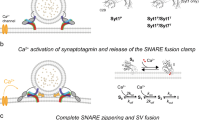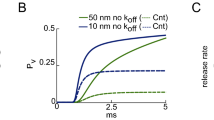Abstract
A stochastic computational approach to the study of secretory processes at the calyx of Held synapse is presented in this paper. The calyx of Held is a giant synapse located in the brainstem which is widely used for experimental recording of neurotransmitter release. We focus on the study of the exocytotic dynamics for a pool of readily releasable vesicles using a Monte Carlo simulation scheme that includes models for the P-type calcium channels, the kinetic reactions of endogenous and exogenous (mobile) buffers, the kinetic reactions for the secretory vesicles, as well as the microscopic diffusion of mobile buffers and calcium ions. The simulations are performed in a 3-D orthogonal grid which approximates a cylindrical domain representing an active zone of the presynaptic terminal of the calyx. For this domain, we quantify the release rates related to calcium currents in response to depolarizing voltage pulses. The influence on simulated pulse/action potential depolarization protocols of the kinetic scheme for the calcium sensor of vesicles and the geometry of calcium channels for the kinetic cooperativity for release, is analyzed at a microdomain level. Among other aspects, our results suggest that the spatial organization of Ca 2 + channels could have measurable effects in the kinetic cooperativity which could reflect developing changes in the calyx of Held synapse.













Similar content being viewed by others
References
Adler, E. M., Augustine, G. J., Duffy, S. N., & Charlton, M. (1991). Alien intracellular calcium chelators attenuate neurotransmitter release at the squid giant synapse. Journal of Neuroscience, 11(6), 1496–1507.
Bartol, T. M., Land, B. R., Salpeter, E. E., & Salpeter, M. M. (1991). Monte Carlo simulation of miniature end-plate current generation in the vertebrate neuromuscular junction. Biophysical Journal, 59(6), 1290–1307.
Bennett, M., Farnell, L., & Gibson, W. (2000). The probability of quantal secretion within an array of calcium channels of an active zone. Biophysical Journal, 78, 2222–2240.
Bollmann, J., Sakmann, B., & Borst, J. (2000). Calcium sensitivity of glutamate release in a calyx-type terminal. Science, 289, 953–957.
Borst, J., & Sakmann, B. (1996). Calcium influx and transmitter release in a fast cns synapse. Nature, 383, 431–434.
Carrera, G., Gil, A., Segura, J., & Soria, B. (2007). Software for simulating calcium-triggered exocytotic processes. American Journal of Physiology Cell Physiology, 292, C749–C755.
Cens, T., Rousset, M., Leyris, J., Fesquet, P., & Charnet, P. (2006). Voltage- and calcium-dependent inactivation in high voltage-gated ca 2 + channels. Progress in Biophysics and Molecular Biology, 90, 104–117.
Collin, T., et al. (2005). Developmental changes in parvalbumin regulate presynaptic ca 2 + signaling. Journal of Neuroscience, 25(1), 96–107.
Dodge, F., & Rahamimoff, R. (1967). Co-operative action of calcium ions in transmitter release at the neuromuscular junction. Journal of Physiology, 193, 419–432.
Dove, L., Abbott, L., & Griffith, W. (1998). Whole-cell and single-channel analysis of p-type calcium currents in cerebellar purkinje cells of leaner mutant mice. Journal of Neuroscience, 18, 7687–7699.
Fedchyshyn, M., & Wang, L. Y. (2005). Developmental transformation of the release modality at the calyx of held synapse. Journal of Neuroscience, 25(16), 4131–4140.
Gentile, L., & Stanley, E. (2005). A unified model of presynaptic release site gating by calcium channel domains. European Journal of Neuroscience, 21, 278–282.
Gil, A., & Segura, J. (2001). Ca3d: A Monte Carlo code to simulate 3d buffered calcium diffusion of ions in sub-membrane domains. Computer Physics Communications, 136, 269–293.
Gil, A., Segura, J., Pertusa, J., & Soria, B. (2000). Monte Carlo simulation of 3-d buffered ca 2 + diffusion in neuroendocrine cells. Biophysical Journal, 78(1), 13–33.
Gilmanov, I., Samigullin, D., Vyskocil, F., Nikolsky, E., & Bukharaeva, E. (2008). Modeling of quantal neurotransmitter release kinetics in the presence of fixed and mobile calcium buffers. Journal of Computational Neuroscience, 25(2), 296–307.
González-Vélez, V., & González-Vélez, H. (2007). Parallel stochastic simulation of macroscopic calcium currents. J. Bioinf. Comput. Biol., 5(3), 755–772.
Grynkiewicz, G., Poenie, M., & Tsien, R. (1985). A new generation of ca 2 + indicators with greatly improved fluorescence properties. Journal of Biological Chemistry, 260, 3440–3450.
Iwasaki, S., et al. (2000). Developmental changes in calcium channel types mediating central synaptic transmission. Journal of Neuroscience, 20, 59–65.
Katz, B., & Miledi, R. (1965). Effect of calcium on acetylcholine release from motor nerve terminals. Proceedings of the Royal Society of London Series B Biological Sciences, 161, 496.
Klingauf, J., & Neher, E. (1997). Modeling buffered ca2 + diffusion near the membrane: Implications for secretion in neuroendocrine cells. Biophysical Journal, 72, 674–690.
Leao, R., & von Gersdorff, H. (2009). Synaptic vesicle pool size, release probability and synaptic depression are sensitive to ca2+ buffering capacity in the developing rat calyx of held. Brazilian Journal of Medical and Biological Research, 42(1), 94–104.
Llinás, R., Sugimori, M., & Silver, R. (1995). The concept of calcium concentration microdomains in synaptic transmission. Neuropharmacology, 34, 1443–1451.
Lou, X., Scheuss, V., & Schneggenburger, R. (2005). Allosteric modulation of the presynaptic ca2+ sensor for vesicle fusion. Nature, 435, 497–501.
Meinrenken, C., Borst, J., & Sakmann, B. (2002). Calcium secretion coupling at calyx of held goverened by nonuniform channel-vesicle topography. Journal of Neuroscience, 22, 1648–1667.
Meinrenken, C., Borst, J., & Sakmann, B. (2003). Local routes revisited: The space and time dependence of the ca 2 + signal for phasic transmitter release at the rat calyx of held. Journal of Physiology, 547, 665–689.
Meir, A., et al. (1999). Ion channels in presynaptic nerve terminals and control of transmitter release. Physiological Reviews, 79(3), 1019–1088.
Neher, E. (1986). Concentration profiles of intracellular calcium in the presence of a diffusible chelator. Experimental Brain Research, 14, 80–96.
Roberts, W. (1994). Localization of calcium signals by a mobile calcium buffer in frog saccular hair cells. Journal of Neuroscience, 14(5), 3246–3262.
Sakaba, T., & Neher, E. (2001a). Calmodulin mediates rapid recruitment of fast-releasing synaptic vesicles at a calyx-type synapse. Neuron, 32, 1119–1131.
Sakaba, T., & Neher, E. (2001b). Quantitative relationship between transmitter release and calcium current at the calyx of held synapse. Journal of Neuroscience, 21(2), 462–476.
Sãtzler, K., et al. (2002). Three-dimensional reconstruction of a calyx of held and its postsynaptic principal neuron in the medial nucleus of the trapezoid body. Journal of Neuroscience, 22, 10,567–10,579.
Schneggenburger, R., & Forsythe, I. (2006) The calyx of held. Cell & Tissue Research, 326, 311–337.
Schneggenburger, R., & Neher, E. (2000). Intracellular calcium dependence of transmitter release rates at a fast central synapse. Nature, 406, 889–893.
Segura, J., Gil, A., & Soria, B. (2000). Modeling study of exocytosis in neuroendocrine cells: Influence of the geometrical parameters. Biophysical Journal, 79, 1771–1786.
Shahrezaei, V., & Delaney, K. (2004). Consequences of molecular-level ca 2 + channel and synaptic vesicle colocalization for the ca 2 + microdomain and neurotransmitter exocytosis: A monte carlo study. Biophysical Journal, 87, 2353–2364.
Shahrezaei, V., & Delaney, K. (2005). Brevity of the ca 2 + microdomain and active zone geometry prevent ca 2 + -sensor saturation for neurotransmitter release. Journal of Neurophysiology, 94, 1912–1919.
Simon, S., & Llinás, R. (1985). Compartmentalization of the submembrane calcium activity during calcium influx and its significance in transmitter release. Biophysical Journal, 48(3), 485–498.
Sun, J., Pang, Z., Qin, D., Fahim, A., Adachi, R., & Sudhof, T. (2007). A dual-ca 2 + -sensor model for neurotransmitter release in a central synapse. Nature, 450, 676–683.
Taschenberger, H., Leão, R., Rowland, K., Spirou, G., & von Gersdorff, H. (2002). Optimizing synaptic architecture and efficiency for high-frequency transmission. Neuron, 36, 1127–1143.
Wang, L. Y., Neher, E., & Taschenberger, H. (2008). Synaptic vesicles in mature calyx of held synapses sense higher nanodomain calcium concentrations during action potential-evoked glutamate release. Journal of Neuroscience, 28(53), 14,450–14,458.
Wu, L., et al. (1999). Calcium channel types with distinct presynaptic localization couple differentially to transmitter release in single calyx-type synapses. Journal of Neuroscience, 19, 726–736.
Zamponi, G. (2005). Voltage-gated calcium channels. Landes Bioscience. New York: Kluwer Academic/Plenum.
Acknowledgements
The authors acknowledge the three anonymous referees for useful comments and suggestions. The authors also acknowledge useful discussions with J. Segura (U. Cantabria) and financial support from I-MATH project C3-0136. V. González-Vélez thanks CONACyT for financial support through her PhD scholarship.
Author information
Authors and Affiliations
Corresponding author
Additional information
Action Editor: Upinder Singh Bhalla
Rights and permissions
About this article
Cite this article
Gil, A., González-Vélez, V. Exocytotic dynamics and calcium cooperativity effects in the calyx of Held synapse: a modelling study. J Comput Neurosci 28, 65–76 (2010). https://doi.org/10.1007/s10827-009-0187-x
Received:
Revised:
Accepted:
Published:
Issue Date:
DOI: https://doi.org/10.1007/s10827-009-0187-x




